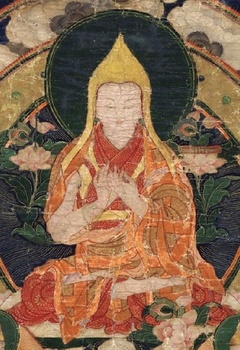Three Principal Aspects of the Path
English | Deutsch | Español | Français | Português | Italiano | བོད་ཡིག
Three Principal Aspects of the Path
by Je Tsongkhapa Lobzang Drakpa
Homage to the precious noble masters!
1. The very essence of all the buddhas’ teachings,
The path that is praised by the noble bodhisattvas,
And the entrance for all fortunate ones desiring liberation—
To the best of my ability, I shall now set forth.
2. You who are unattached to saṃsāra’s pleasures,
And strive to make full use of the freedoms and advantages,
You who follow the path delighting all the buddhas—
Fortunate ones, listen well, with a clear and open mind.
3. Whilst lacking pure renunciation there is no way to pacify
The continual thirst for pleasure in the ocean of saṃsāra,
And since all living beings are bound by their craving for existence,
You must begin by finding the determination to be free.
4. The freedoms and advantages are rare, and there’s no time to waste—
Reflect on this again and yet again, and dispel attachment to this life.
To dispel attachment to your future lives, contemplate repeatedly
The unfailing effects of karma and the sufferings of saṃsāra.
5. When, through growing accustomed to thinking in this way,
Hope for the pleasures of saṃsāra no longer arises even for an instant,
And throughout both day and night you long for liberation,
Then, at that time, true renunciation has been born.
6. Yet if this renunciation is not embraced
By the pure motivation of bodhicitta,
It will not become a cause for the perfect bliss of unsurpassed awakening,
So the wise should generate supreme bodhicitta.
7. Beings are swept along by the powerful current of the four rivers,[1]
Tightly bound by the chains of their karma, so difficult to undo,
Ensnared within the iron trap of their self-grasping,
And enshrouded in the thick darkness of ignorance.
8. Again and yet again, they are reborn in limitless saṃsāra,
And constantly tormented by the three forms of suffering.[2]
This is the current condition of all your mothers from previous lives.
Contemplate their plight and generate supreme bodhichitta.
9. If you lack the wisdom that realizes the nature of things,
Although you might grow accustomed to renunciation and bodhicitta,
You will be incapable of cutting through conditioned existence at its root.
Exert yourself, therefore, in the methods for realizing interdependence.
10. The one who sees that cause and effect operate infallibly
For all the phenomena of saṃsāra and nirvāṇa,
And for whom any objects of conceptual focus have subsided,
Has set out upon the path delighting all the buddhas.
11. The knowledge that appearances arise unfailingly in dependence,
And the knowledge that they are empty and beyond all assertions—
As long as these two appear to you as separate,
There can be no realization of the Buddha’s wisdom.
12. Yet when they arise at once, not each in turn but both together,
Then through merely seeing unfailing dependent origination
Certainty is born, and all modes of misapprehension fall apart—
That is when discernment of the view has reached perfection.
13. When you know that appearances dispel the extreme of existence,
While the extreme of nothingness is eliminated by emptiness,[3]
And you also come to know how emptiness arises as cause and effect,
Then you will be immune to any view entailing clinging to extremes.
14. When, in this way, you have correctly understood
The key points of the three principal aspects of the path,
Withdraw to solitude, dear son, strengthen your diligence,
And swiftly accomplish the ultimate and lasting aim.
This advice was given by the bhikṣu of extensive learning, Lobzang Drakpé Pal, to Tsakho Önpo Ngawang Drakpa.
| Translated by Adam Pearcey, 2006. Revised 2012.
Bibliography
Tibetan Edition
blo bzang grags pa'i dpal. "lam gyi gtso bo rnam gsum/" in 'jam mgon kong sprul blo gros mtha' yas, bkra shis dpal 'byor (ed.). gdams ngag mdzod/. 18 vols. Paro: Lama Ngodrup and Sherab Drimey, 1979–1981 (BDRC W20877). Vol. 4: 435–438
Version: 2.2-20211228
-
According to Ngulchu Dharmabhadra, this refers either to the sufferings of birth, old age, sickness and death, or to the four rivers of desire, becoming, ignorance and belief. ↩
-
Suffering of suffering, the suffering of change and the all-pervasive suffering of conditioned existence. ↩
-
It is commonly said that the fact that things appear eliminates the extreme of nihilism or a belief in the total non-existence of things, and that emptiness dispels the extreme of eternalism, or the belief in things as truly existent. Here, Tsongkhapa goes further and says that the fact that things appear dispels the extreme of taking things to be truly existent, because for things to appear they must lack inherent existence. Moreover, the fact that things are empty eliminates the extreme of non-existence, since it is only because things are empty that they can appear. ↩
